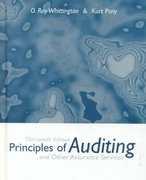Select the best answer for each of the following questions. Explain the reasons for your selection. a.
Question:
Select the best answer for each of the following questions. Explain the reasons for your selection.
a. Which of the following is an element of sampling risk?
(1) Choosing an audit procedure that is inconsistent with the audit objective.
(2) Concluding that no material misstatement exists in a materially misstated population based on taking a sample that includes no misstatement.
(3) Failing to detect an error on a document that has been inspected by an auditor.
(4) Failing to perform audit procedures that are required by the sampling plan.
b. In assessing sampling risk, the risk of incorrect rejection and the risk of assessing control risk too high relate to the
(1) Efficiency of the audit.
(2) Effectiveness of the audit.
(3) Selection of the sample.
(4) Audit quality controls.
c. In which of the following circumstances is it least likely that tests of controls will be performed?
(1) The expected deviation rate exceeds the tolerable deviation rate.
(2) The planned assessed level of control risk is at a level slightly below the maximum.
(3) The risk of assessing control risk too low is less than the expected deviation rate.
(4) The tolerable deviation rate exceeds the risk of assessing control risk too low.
d. An auditor needs to estimate the average highway weight of tractor-trailer trucks using a state's highway system. Which estimation method is most appropriate?
(1) Mean-per-unit.
(2) Difference.
(3) Ratio.
(4) Probability-proportional-to-size.
\(e\). The auditors have sampled 50 accounts from a population of 1,000 accounts receivable. The sample items have a mean book value of \(\$ 200\) and a mean audited value of \(\$ 203\). The book value in the population is \(\$ 198,000\). What is the estimated audited value of the population using the mean-per-unit method?
(1) \(\$ 198,000\)
(2) \(\$ 200,000\)
(3) \(\$ 201,000\)
(4) \(\$ 203,000\)
\(f\). Using the same facts as in \(e\) above, what is the estimated total audited value of the population using the difference method?
(1) \(\$ 198,000\)
(2) \(\$ 200,000\)
(3) \(\$ 201,000\)
(4) \(\$ 203,000\)
Step by Step Answer:

Principles Of Auditing And Other Assurance Services
ISBN: 9780072327267
13th Edition
Authors: Ray Whittington, Kurt Pany





